#Description :
Text
#legacies#avalance#Marisa Papen#dick grayson#vape#blunt#woozi#puppylove#description#soulmate au#race and politics
122 notes
·
View notes
Text
#Yakusoku No Neverland#kate middleton#crossfit#legacies#Marisa Papen#vape#woozi#puppylove#description#soulmate au#race and politics#todobakudeku
120 notes
·
View notes
Text
https://anna-685.mxtkh.fun/wf/oPGqNSs
#Yakusoku No Neverland#minimalist#kate middleton#kristen wiig#crossfit#fundraising#legacies#avalance#Marisa Papen#dick grayson#vape#blunt#woozi#puppylove#description
125 notes
·
View notes
Text


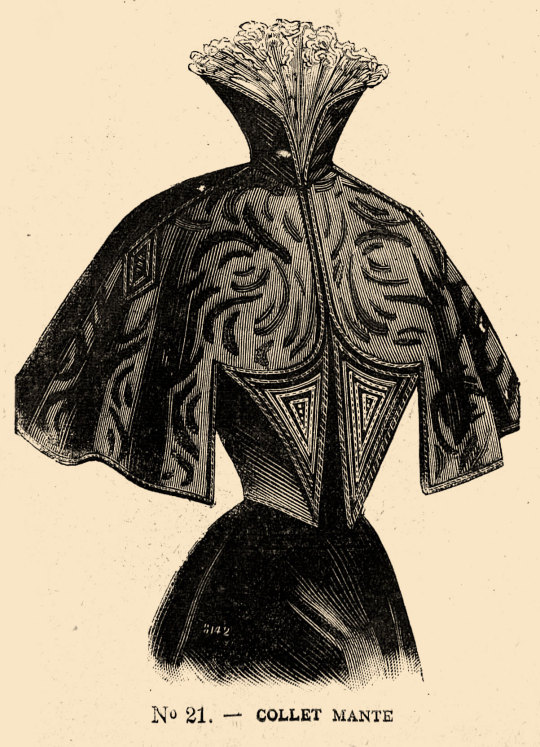
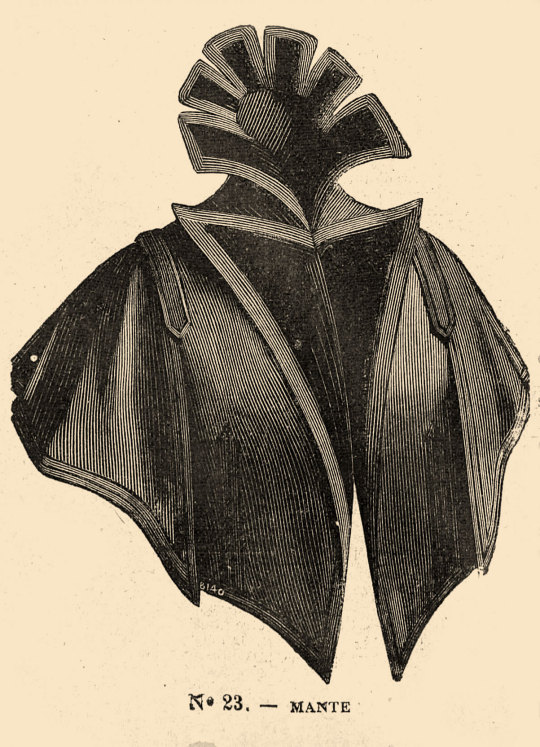
La Mode nationale, no. 22, 5 juin 1897, Paris. No. 14. — Petite mante. No. 17. — Mante. No. 21. — Collet mante. No. 23. — Mante. Bibliothèque nationale de France
No. 14. — Petite mante en soie brochée rose sur beige, froncée sur les épaules et remonte dans le haut par un collet formé par des feuilles de satin noir, avec broderies de jais en dessus, petite dentelle autour des feuilles, autour du cou grosse ruche retenue par une draperie de mousseline de soie enroulée et nouée en gros nœuds sur les côtés.
No. 14. — Small pink-on-beige embroidered silk mantle, gathered on the shoulders and raised at the top by a collar formed by black satin leaves, with jet embroidery above, small lace around the leaves, around the neck large ruffle held by a drapery of silk muslin rolled up and tied in large knots on the sides.
—
No. 17. — Mante de drap gris allant plus bas que la taille, montée sur un col Médicis doublé de dentelle blanche; devant, longs revers brodés de soutache noire, même broderie dans le dos.
No. 17. — Gray cloth mantle reaching below the waist, mounted on a Medici collar lined with white lace; front, long lapels embroidered with black soutache, same embroidery on the back.
—
No. 21. — Collet mante de soie brochée vert amande et rouge montée sur haut col Médicis doublée de dentelle; dans le bas, ceinture corselet à revers faisant la mante courte sur le devant.
No. 21. — Collar of almond green and red embroidered silk mantle mounted on a high Medici collar lined with lace; at the bottom, corselet belt with cuffs making the short mantle on the front.
—
No. 23. — Mante de satin vert bouteille montée sur col Médicis, coupé de créneaux doublés de pattes de velours noir, mante à pointes devant et dans le dos, avec grands revers de velours.
No. 23. — Bottle green satin mantle mounted on a Medici collar, cut with crenellations lined with black velvet tabs, pointed mantle in front and back, with large velvet lapels.
#La Mode nationale#19th century#1890s#1897#on this day#June 5#periodical#fashion#fashion plate#description#bibliothèque nationale de france#dress#cape#collar#mantle
33 notes
·
View notes
Text
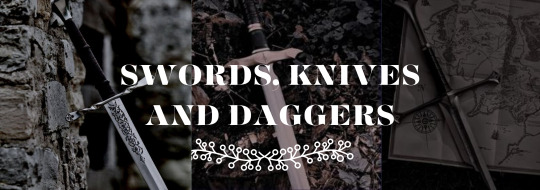
Writing Weapons (1): Swords
The Thrusting Sword
Type of fight scene: entertaining, duels, non-lethal fights, non-gory deaths, swashbuckling adventure
Mostly used in: Europe, including Renaissance and Regency periods
Typical User: silm, male or female, good aerobic fitness
Main action: thrust, pierce, stab
Main motion: horizontal with the tip forward
Shape: straight, often thin, may be lightweight
Typical Injury: seeping blood, blood stains spreading
Strategy: target gaps in the armous, pierce a vital organ
Disadvantage: cannot slice through bone or armour
Examples: foil, epee, rapier, gladius
The Cleaving Sword
Type of fight scene: gritty, brutal, battles, cutting through armour
Typical user: tall brawny male with broad shulders and bulging biceps
Mostly used in: Medieval Europe
Main action: cleave, hack, chop, cut, split
Main motion: downwards
Shape: broad, straight, heavy, solid, sometime huge, sometimes need to be held in both hands, both sides sharpened
Typical Injury: severed large limbs
Strategy: hack off a leg, them decapitate; or split the skull
Disadvantage: too big to carry concealed, too heavy to carry in daily lifem too slow to draw for spontaneous action
Examples: Medieval greatsword, Scottish claymore, machete, falchion
The Slashing Sword
Type of fight scene: gritty or entertaining, executions, cavalry charge, on board a ship
Mostly used in: Asia, Middle East
Typical user: male (female is plausible), any body shape, Arab, Asian, mounted warrior, cavalryman, sailor, pirate
Main action: slash, cut, slice
Main motion: fluid, continuous, curving, eg.figure-eight
Shape: curved, often slender, extremely sharp on the outer edge
Typical Injury: severed limbs, lots of spurting blood
Strategy: first disable opponent's sword hand (cut it off or slice into tendons inside the elbow)
Disadvantage: unable to cut thorugh hard objects (e.g. metal armor)
Examples: scimitar, sabre, saif, shamshir, cutlass, katana
Blunders to Avoid:
Weapons performing what they shouldn't be able to do (e.g. a foil slashing metal armour)
Protagonists fighting with weapons for which they don't have the strength or build to handle
The hero carrying a huge sword all the time as if it's a wallet
Drawing a big sword form a sheath on the back (a physical impossiblity, unless your hero is a giant...)
Generic sword which can slash, stab, cleave, slash, block, pierce, thrust, whirl through the air, cut a few limbs, etc...as if that's plausible
adapted from <Writer's Craft> by Rayne Hall
#writing#writers and poets#writers on tumblr#creative writing#let's write#poets and writers#creative writers#writeblr#resources for writers#helping writers#fantasy#sword#sword fighting#fight scene#historical fantasy#adventure fiction#description#writing practice#writing prompt#writing inspiration#writing ideas#on writing#writer#writerscommunity#writing advice#writing community#writer stuff#writers life#writers community#writers block
1K notes
·
View notes
Text

Charles Baudelaire, from Modern Poets of France: An Anthology; “Hymn to Beauty”
1K notes
·
View notes
Text
A Careful Balance: Portraying a Black Character's Relationship with their Hair
@writingraccoon said:
My character is black in a dungeons and dragons-like fantasy world. His name is Kazuki Haile (pronounced hay-lee), and his mother is this world's equivalent of Japanese, which is where his first name is from, while his father is this world's equivalent of Ethiopian, which is where his last name is from. He looks much more like his father, and has hair type 4a. I plan to make his character very finnicky about his hair, both enjoying styling it, but also often being unsure how to style it (not in that he doesn't know how to, but has so many options for how to style it, he has trouble choosing). However, I know that there are some very harmful ways to write black hair, especially in regards to how the black character themselves feels about it. Kazuki does not hate his hair, in fact he takes joy in it, and I'm researching black hair and hair styles to be as accurate as possible. But I'm unsure if portraying a black character as occasionally overwhelmed by or vain about his hair is negative. How would you suggest either changing this or making it work? Does it need to be changed in the first place?
Black Character Overwhelmed by Curly Afro Hair
Your Black character wanting his hair to look its best and at times feeling overwhelmed seems reasonable and natural to me. It appears their challenge comes with how to style it. Not so much with struggling how it looks or how hard it is to manage. That is good, as this further helps avoid placing a strong negative focus on Black hair.
Him caring a lot about how it is style should not be deemed vain or frivolous, either. In any case, hair care is self care. There’s nothing wrong with having pride with your hair, especially hair that mainstream society, historically and present, might say is not beautiful. This still matters, even in a fantasy world, since your readers still exist in this reality. It’s empowering and a welcome change to see someone who loves their afro hair, actually.
There are unique factors someone with coily afro hair would experience vs. straight, wavy, or looser curls, but people struggling with their hair (too frizzy, too flat, too limp, too thin, too thick!) is universal.
There is a delicate balance to achieve.
Avoid Writing a Black Hair Journey Experience
An overall negative Afro hair journey might be the reality for many, especially when society deems Afro hair as unacceptable and slaps so many uninvited opinions, laws and policies over its existence and on certain styles (again, historically and very much at present), but that’s the kind of story that is best handled by someone with the background. Someone willing to commit to the research might also be able to pull it off, although it’s truly not the kind of thing an escapism novel needs in my opinion. If the story is not meant to delve into “A Black /Black Hair Experience” then I'd avoid going that route. That is moving a bit towards a struggle narrative, depending on how much it defines your character’s story.
Add positive and neutral hair language and interactions
For your writing, I’d avoid using unchallenged negative language about his hair. Being overwhelmed at times and frustrated is one thing and expected. If his hair is constantly brought up, and is associated with uncontrollable, ugly, or too [insert struggle here], then rethink the direction you’re going.
Add some positive or neutral terms, reactions, and interactions in the narrative towards afro hair, such as describing color and texture.
“His fine coils bounced in the wind.”
“Hair black and shiny”
“She wore her hair in two large, fluffy buns.”
“He admired his fresh, neat braids in the mirror, smiling at his reflection, before turning to leave.”
Another tip: It may have been for research purposes, but leave out any hair number categorizing in the story and rely on description. I’d say this goes for any story, as reading the number would feel off.
“He had coily 4a hair.” Nahh! :P
Also, I would suggest sending all passages that focus on his hair to a Black sensitivity reader for review.
More reading:
~Mod Colette
#asks#black#black hair#hair#afro hair#description#tragedy exploitation#struggle novel#creator responsibility#representation#guides#writeblr
2K notes
·
View notes
Text

ID: a petfinder listing for a black and white cat named Aro. He is from Springfield, Missouri and is listed as a young, medium-sized domestic short hair mix. The picture of him is taken from above, and he is looking up at the camera. He is mostly black with a white chest and white paws. /end ID
#petfinder#catfinder#cat#kitten#kitty#aro#black tuxedo#mo#missouri#submission#desc#description#described
644 notes
·
View notes
Text
Listen, I know we all have stuff to do and summer is coming up and aaaaaaaargh, but in the name of Optimus Prime I'm begging y'all to shed the habit of using descriptors like 'the shorter one' or 'the blond one' instead of using proper names.
This is a very common trope in fanfiction, and I get it, it gets so boring to write the character names over and over again. I also know it will be so hard to unlearn, don't ask me about the pain and suffering I have endured. But you have to break yourself out of this habit, because all it's doing is making your stories harder to follow and losing your readers.
Let's say you're writing an Avengers fanfic, and you've got Captain America, Iron Man, and Thor in the room together. The following scene might go a little something like this:
"We must stop Unicron," the blond one said, flexing his muscles.
"Indeed," the dark-haired one replied. "If only he weren't so handsome for a metal monster."
"Thou is speaking nonsense," the bearded man said, subtly flexing his biceps harder. "Also, who is speaking right now?"
(Yes, I did write Unicron instead of Ultron like I'm pretending not to be a nerd, shut up.)
The actual dialogue tag indicators above are nonsense, pure gibberish, and those exaggerated for effect, wouldn't it just be easier to follow if you just used names? Also, sometimes Tony's goatee is more beard-like so it's even less helpful in figuring out who's talking. Depends on what era of comics you're reading.
ANYWAY, Who is doing what is one of the most important things you need to convey. In a busy dialogue scene, in a high action scene, especially in a romance scene between two people of the same gender, clarity is key. It feels boring to write, I know. It will be a better scene in the end.
So when should you use character descriptors in your writing?
When you need to reiterate an important character feature that is either relevant to how the main character views them or how they view themselves. Example: Her brother, the soldier, the Hobbit, etc.
When you need to reiterate an important character feature to the plot. Example: The god of thunder, the stowaway, the white witch, etc.
When you have a minor character who is better defined by their job or role than there name. Example: The second mate, the boatswain, the cook, etc.
When appropriate to the scene. This one is harder to define, but if you have a quiet moment where the main character reflects on the scoundrel he has a crush on, long paragraphs of just using the name Alex might be better peppered descriptors of his personality or notable features, or - depending on your character - 'that cocky asshole.'
When shouldn't you use character descriptors? When they are boring, unhelpful, and not distinctive. Referring constantly to someone as "the taller man" or "the blonde" will come back to haunt your ass years down the road, believe me. Break free from this prison before you snap awake at 3am, haunted by the one stupid scene you can never unwrite.
#description#writing advice#describing characters#break the ghosts of fanfic of the past#I'm not yelling at you I'm yelling at my younger self#hopefully obviously
267 notes
·
View notes
Note
Holaa, description wise how do you make a regular person appear absolutely terrifying to the audience besides motivation?
What they do/say - the easiest way to build character and tension is through what characters do or say. Are they being threatening in any way? Do they have a weapon that would turn an otherwise unremarkable person suddenly into a threat? Why is this character scary? Why would people think that about them? I'm going to assume by 'regular person' that they don't look absolutely terrifying or intimidating in anyway.
Reputation - build up the stakes before we ever actually see them. This could be other characters talking about them/what they've done, or in-universe myth about them or whatever. This helps build tension, both by making us wait to meet this character and because we are only getting second-hand information for a while and so we can't be 100% sure what's true or not.
Similarly, what do we know about them? If we know someone is a terrifying serial killer (e.g. Hannibal Lecter) it doesn't matter if they are also currently being quite pleasant on the screen/page and seem otherwise regular. We might still think twice before coming over for dinner. (See also, use of dramatic irony).
Contrast - are we seeing them next to a character who should be absolutely terrifying? But that terrifying character is responding to the regular person in a way that hints perhaps not all is at it seems.
Context - are we seeing them in a setting that's just off? E.g. if the regular, smiley human is being regular and smiley in the middle of a slaughter zone, it's going to start creeping us out. If people are behaving completely normal in otherwise abnormal scenarios it can make our instincts twinge.
Perspective. Whose perspective is the description coming from? A child might find a regular old lady terrifying in a way that an adult, who has more information about what is actually going on, would not.
#hope this helps#writing talk#writing advice#writing#writing tips#description#writing help#writing resources
240 notes
·
View notes
Text
The wind howled. Lightning stabbed at the earth erratically, like an inefficient assassin. Thunder rolled back and forth across the dark, rain-lashed hills.
The night was as black as the inside of a cat. It was the kind of night, you could believe, on which gods moved men as though they were pawns on the chessboard of fate. In the middle of this elemental storm a fire gleamed among the dripping furze bushes like the madness in a weasel's eye. It illuminated three hunched figures. As the cauldron bubbled an eldritch voice shrieked: “When shall we three meet again?”
There was a pause.
Finally another voice said, in far more ordinary tones: “Well, I can do next Tuesday.”
— Wyrd Sisters (Terry Pratchett)
#book quotes#fantasy fiction#terry pratchett#discworld#wyrd sisters#description#weather#storms#wind#lightning#thunder#rain#night#darkness#imagination#witches#humour
719 notes
·
View notes
Text
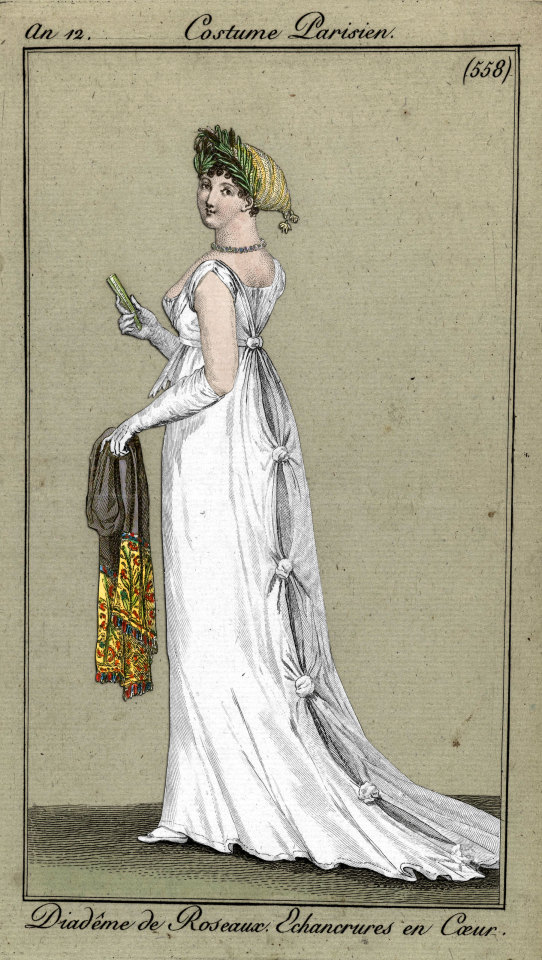
Journal des Dames et des Modes, Costume Parisien, 4 juin 1804, An 12, (558): Diadême de Roseaux. Echancrures en Coeur.
Woman, seen from the back, with a reed diadem in her hair. She wears a dress with center back cutouts. Short sleeves and train. Further accessories: necklace, fan, long gloves, scarf with floral and leaf motif, flat shoe. The print is part of the fashion magazine Journal des Dames et des Modes, published by Pierre de la Mésangère, Paris, 1797-1839.
#Journal des Dames et des Modes#19th century#1800s#1804#on this day#June 4#periodical#fashion#fashion plate#color#description#rijksmuseum#dress#shawl#diadem
23 notes
·
View notes
Text
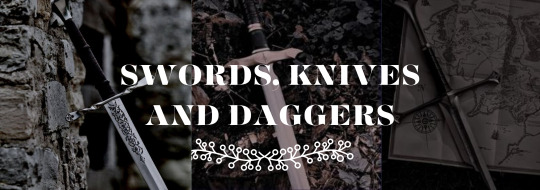
Writing Weapons (2): Knives and Daggers
Dagger vs. Sword
In many situations, daggers might be more plausible than a sword fight.
Dagger are eaiser to carry and conceal, lighter, faster, good for spontaneous action, suicide bids, self-defense and assassination.
Dagger vs. Knife
No clear distinction; terms used interchangeably
Dagger is more for thrusting with 2 sharp edges
Knife is more for cutting (slashing) with 1 sharp edge
Concealment
Carried in a leather sheath on the belt
Can be concealed under a cloak, in a bodice (sheath sewn into the bodice), in a boot, behind hari ornaments
Bodice daggers (popular in the Renaissance) had no cross guards.
Connotations
Beside its combat value, the dagger has lots of emotional and sexual symbolisms.
The closeness need to attack with a dagger creates intense personal connection. They are often used in fights where emotions are running high: gang warfare, hate crime, vengeance.
Due to its shape and the fact that it's usually worn on a belt made it a symbol of virility in many cultures and periods.
Sometimes it was the hilt rather than the blade: like in the case of bollocks daggers with two...balls on either side of the hilt.
Fighting Techniques
Stabbing:-
The dagger with long, thin blades are made to stab a vital organ like the kidneys, liver, bowel, stomach or heart.
Stabbing directly at the chest seldom works, since the blde may glance off the ribs. Position the dagger below the ribcage and drive it upwards, through the diaphragm and into the lungs. If the sword is long enough and your fighter is a professional, you can get to the heart.
If no professional, just keep going for the stomach and you'll get one of the vital organs eventually.
Slashing:-
When describing a slash wound, show a lot of blood streaming, or even spurting.
Slashing dagger fights are bloody - show your MC's hands getting slick with blood, grip on the weapon slipping.
The aim is to cut the opponent's throat or cut tendoms, muscles, or ligaments to disable. Slashing the muscles in the weapon-wielding arm is the most effective; insides of the writst or back of the knee is also critical.
Assassinations:-
Show good knowledge of the humna antatomy
Use a stabbing dagger
A single, determined, calculated and efficient stroke, probably below the ribs.
Self-Defense:-
Disable the attacker by slashing their weapon-wielding hand (elbow or wrist)
Quick, multiple stabs wherever the MC can get the blade to land; the attacker won't give time for careful positioning
If the blade is too short to do any significant damage, maek up for this by stabbing so ast that the pain and blood loss distracts the opponent.
Vegeance and Hatred:-
Someone who is motivated by raging emotions will stab the victim repeatedly, even after he is already dead.
The attacker may stab or salsh the victim's face, disfiguring it.
Contemporary street fights and gang warfare usually involves these.
Duels:-
If both fighters are armed with daggers, include wrestling-type moves as they try to restrict each other's weapon hand.
Show them trying to disable each other by slashing insides of writes, elbows, the back of the knees, etc.
Dagger + Sword
If the character is expecting a fight, they can hold a sword in their right hand, and a dagger in their left to fight with both
Sword + mace combination also common.
Blunders to Avoid:
Direct stabbing at the chest wouldn't work.
Hero cannot cut his bread with a stabbing sword
adapted from <Writer's Craft> by Rayne Hall
#writing#writers and poets#writers on tumblr#helping writers#creative writing#writeblr#let's write#poets and writers#creative writers#resources for writers#dagger#fight scene#description#action scene#writer#write#fantasy#medieval fantasy#high fantasy#fantasy world#writer on tumblr#ao3 writer#writer problems#writer stuff#writer community#writer things#author#writing practice#writing prompt#writing inspiration
894 notes
·
View notes
Text
Black woman’s skin turns blue from powers; is this whitewashing/erasure?
Anonymous asked:
I have a character in a comic I'm hoping to write one day. She's a light skinned black woman(she's half white if that helps!) living in New York City during an 80s themed post nuclear apocalypse. The comic's main characters are all rock stars, so a lot of the character design elements revolve around the different rock genres. The character in question is in a glam rock band, so there's lots of bright, saturated, crazy colors involved in her design.
The problem I'm having involves this one story beat where she gets mutant superpowers that give her electricity and sound based abilities. Her skin turns cotton candy blue as a result of the mutation. I'm hung up on whether or not this might fall under some kind of skin lightening or white-washing trope since it's a fairly light shade of blue. I designed her mutant look before her human look, so this was well before I'd even figured out what race she was, and I simply thought the shade of blue would compliment both the electricity powers and the fact that her hair is dyed pink. Is there a way I could still make this work? Or am I worrying about nothing?
Ideally, it would be nice to keep her brown skin tone. There’s a common comic and supernatural trend where Black people’s skin is covered up by a suit or Black-coded characters are an unnatural color (blue, green, purple, etc).
This is more of an issue when:
There are no other Black characters of those identities besides the covered up/ ones with unnatural skin colors.
The creator adds this change to make them "special" because they do not believe Black characters, with features commonly associated with Black people like dark hair, skin and eyes, are acceptable enough for the character to stand on their own.
The supernatural special Black people are treated well by the story. The "non-special" Black people have unhappy stories and misfortune.
Other races of characters do not get their skin covered up or changed. Only the Black ones and/or BIPOC in general.
I think a quick fix for this would be for her skin to turn blue when she’s actively using her powers, at random, or other specific times, besides constantly. If she needs to be more consistently “mutant looking” Are there other ways she could change without her skin color changing or changing completely?

People with glitter on skin, light surrounding their face, and blue braids. Images from pexels.
More ideas that keep her skin brown
Hair
Her hair color changes blue or your color of choice (which could include body hair too, which would give her a more “otherworldly” appearance).
Note: If her hair is curly or natural, please keep it so! At least, the powers shouldn't change it straight.
Eyes
Her eyes glowing brighter or colorfully during power-use.
Note: If they're usually brown, they could stay brown when powers not in use, like Marvel's Storm in some versions.
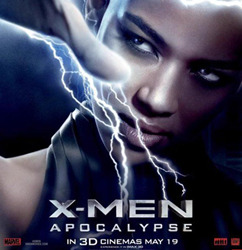
Storm by Marvel Entertainment//20th Century Studios.
Skin and body
Blue patterns appear on her skin.
Blue glow or sheen to her skin without fully changing the color.
Her skin projects color and light.
New growths or changes to body, such as ear shape, wings, etc.
No matter what you decide, please make clear in your tale that she’s a Black mixed race woman. And have fun!
More reading:
How Special is Too Special? The Politics and Characterization of Stacking Special/Abnormal Traits on Mixed Race Characters
~Colette
1K notes
·
View notes
Text

ID: a petfinder listing for a wide-eyed young black cat named Baby Bear. He is a medium-sized domestic short hair mix from Bolivar, Missouri. His yellow eyes are wide and perfectly circular, making him look surprised as he turns to face the camera. /end ID
#petfinder#catfinder#cat#kitten#kitty#baby bear#solid black#mo#missouri#submission#desc#description#described
418 notes
·
View notes
Text
https://christine-083.sxxyo.icu/n/3glxVva
#kristen wiig#crossfit#fundraising#legacies#avalance#dick grayson#blunt#puppylove#description#soulmate au
121 notes
·
View notes